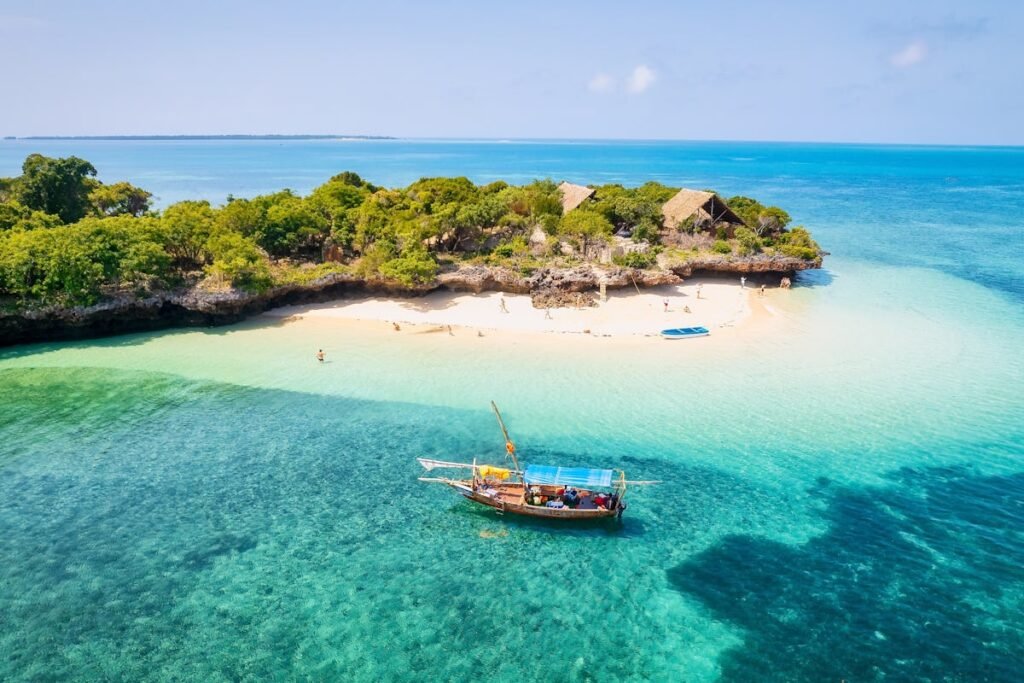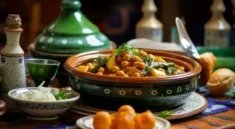
Off the coast of East Africa, in the turquoise waters of the Indian Ocean, lies an archipelago where time seems to pause. With its powdery white sand beaches, gently swaying palm trees, and crystalline waters, Zanzibar is a paradise not just for sun-seekers, but also for those with a passion for history and culture. This semi-autonomous region of Tanzania is more than just an island getaway—it is a living mosaic of Swahili heritage, shaped over centuries by African, Arab, Persian, Indian, and European influences.
Whether you’re walking through the winding alleyways of Stone Town, sailing on a traditional dhow under the stars, or sharing a spicy meal with a local family, Zanzibar invites you to explore its unique blend of natural beauty and cultural depth. This is a land where white sand beaches meet centuries of seafaring history, and where the legacy of the Swahili people is written in coral stone, music, and the daily rhythm of life.
A Glimpse of Paradise: Zanzibar’s White Sand Beaches
The first thing that strikes any visitor to Zanzibar is the sheer beauty of its coastline. Beaches here are among the most breathtaking in the world—expanses of soft, powdery white sand lapped by aquamarine waters that seem to shift color with the sky.
On the island’s eastern shore, the beach towns of Paje, Jambiani, and Bwejuu offer long stretches of idyllic shoreline framed by palm groves. These beaches are perfect for long walks, sunbathing, and swimming. At low tide, the ocean recedes dramatically, revealing tidal pools where locals harvest seaweed and children play in the shallow surf.
The northern beaches of Nungwi and Kendwa are known for their stunning sunsets and vibrant beach culture. Here, the tide is less extreme, making the waters ideal for year-round swimming. The sands are warm and golden, and the atmosphere comes alive in the evenings with music, bonfires, and beachside restaurants serving up fresh seafood with a Zanzibari twist.
For those seeking seclusion, Matemwe and Michamvi offer tranquil stretches of coastline far from the bustle, where traditional wooden dhows glide silently over the horizon and the only sound is the whisper of waves.
The Soul of the Island: Swahili Culture and Daily Life
The heart of Zanzibar lies in its people and their deeply rooted Swahili culture—a unique blend of Bantu, Arab, Persian, and Asian influences that have developed over more than a millennium of trade and interaction. This culture is not only seen but felt—in the rhythms of Taarab music, in the aroma of spiced coffee, and in the warm greetings of “Karibu!” (“Welcome!”) heard throughout the island.
Swahili, both the language and the cultural identity, originates along the East African coast, and Zanzibar has long been one of its most important centers. The architecture, clothing, cuisine, and customs of the island are deeply tied to this identity.
In villages like Makunduchi and Kizimkazi, life moves at a slower, more deliberate pace. You may see fishermen mending nets, women in colorful kanga fabrics weaving baskets or preparing pilau over open fires, and children playing football barefoot on the beach. The Swahili lifestyle embraces hospitality, community, and a spiritual connection to nature and ancestors.
Visiting during a festival such as Mwaka Kogwa—a traditional New Year’s celebration featuring music, ritual combat, and community feasts—offers an unforgettable immersion into the island’s living traditions.
Stone Town: A Crossroads of Civilizations
No visit to Zanzibar is complete without stepping into Stone Town, a UNESCO World Heritage Site and the cultural and historical heart of the island. Its narrow streets, carved wooden doors, and sun-dappled courtyards are a testament to centuries of cross-cultural exchange.
Wandering through the labyrinthine alleys, one discovers ancient mosques, Omani palaces, Portuguese forts, Indian-style merchant houses, and British colonial buildings—all coexisting within the same few square kilometers. The House of Wonders, once the largest building in East Africa, still stands as a symbol of Zanzibar’s former sultanate splendor. Nearby, the Old Fort and the Sultan’s Palace Museum reveal the power and sophistication of Zanzibar’s ruling elite during the 18th and 19th centuries.
Yet, Stone Town is not frozen in time. It is alive with markets brimming with spices, children playing under ancient arches, and calls to prayer echoing from minarets. The bustling Darajani Market is an essential stop, where locals shop for everything from fish to fabrics, and the scent of cloves, cinnamon, and cardamom fills the air.
At sunset, the Forodhani Gardens Night Market comes alive, offering an array of street foods—from Zanzibar pizzas to grilled octopus, sugarcane juice, and samosas. Here, one can savor the true flavor of Swahili cuisine while watching dhows drift lazily across the sea.
Maritime History: Dhows, Spice Routes, and Sultanates
Zanzibar’s location in the Indian Ocean made it a crucial hub for centuries of maritime trade. Beginning as early as the 1st millennium, Arab and Persian traders sailed with the monsoon winds to reach East Africa, bringing with them goods, religion, and culture. By the 18th century, Zanzibar had become the seat of the Omani Sultanate, and later, a key node in the global spice and slave trades.
The traditional dhow, a wooden sailing vessel with a triangular lateen sail, is a symbol of this era. These boats are still built and used today, connecting past and present. Watching a fleet of dhows silhouetted against the setting sun, one can almost imagine the days when Zanzibar’s harbor bustled with cargoes of cloves, ivory, and gold.
Zanzibar was once known as the “Spice Island,” and its legacy continues in the spice plantations of the interior. Guided spice tours introduce visitors to the plants behind everyday flavors—vanilla orchids, pepper vines, ginger roots, and clove trees. These tours are more than botanical experiences; they are windows into Zanzibar’s economic and colonial past.
Equally significant, and sobering, is the island’s role in the East African slave trade. The Slave Market Memorial, located in Stone Town, marks the site of one of the largest slave markets in East Africa. Beneath the Anglican Cathedral are holding chambers where enslaved people were once imprisoned. Visiting this site is a powerful reminder of the human cost of empire and trade, and a tribute to the resilience of those who suffered.
Adventure, Relaxation, and Marine Wonders
Beyond history and culture, Zanzibar is also a destination for adventure and ecological exploration. The Mnemba Atoll, a protected marine area off the northeast coast, offers world-class snorkeling and diving. Coral gardens teeming with tropical fish, sea turtles, and even dolphins await those who venture beneath the surface.
Sea kayaking, kitesurfing, and sailing are popular activities in Paje and Nungwi, while inland excursions include forest hikes through Jozani Chwaka Bay National Park, home to the endangered red colobus monkey, found only on Zanzibar.
For those seeking ultimate relaxation, the island’s many resorts and eco-lodges provide luxurious experiences that remain sensitive to local culture and the environment. Sunset cruises on traditional dhows, yoga retreats overlooking the ocean, and beachside massages using local coconut oil allow travelers to connect deeply with this idyllic place.
Conclusion: A Timeless Coastal Treasure
Zanzibar is not merely a beach destination—it is a layered and soulful journey. It’s where soft sands meet centuries-old stories, where every wave carries whispers of ancient sailors, and where Swahili culture blooms in every corner, both sacred and mundane.
Whether you come for the beaches, the culture, or the history, Zanzibar welcomes you not just as a visitor, but as a participant in a living legacy. From the echoing chants of the muezzin in Stone Town to the quiet rustle of palms on deserted shores, this island invites you to slow down, open your heart, and listen to the tales of a place where white sand beaches, Swahili culture, and rich maritime history converge in perfect harmony.




